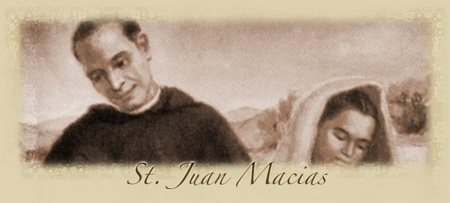The collect for the Mass noted above speaks of volumes of this beautiful woman. Blessed Lucy was born in 1476, died in 1544 and beatified in 1710. She was a stigmatist, that is, she bore the wounds of Christ’s in her body. A review of Blessed Lucy’s life is noted here and more can be found here.
Tag: Dominican saints and blesseds
Saint Louis Bertrand
 Proclaim the glory of the Lord among the nations; God’s marvelous deeds to all the peoples; great is the Lord and worthy of all praise.
Proclaim the glory of the Lord among the nations; God’s marvelous deeds to all the peoples; great is the Lord and worthy of all praise.
Saint Juan Macias
Come, you whom my Father has blessed, says the Lord; I was ill and you comforted me. I tell you, anything you did for one of these you did for me.
Blessed Catherine Racconigi
 O Lord, our hope, You enriched Blessed Catherine with an abundance of heavenly gifts and filled her heart with You alone. With the help of her prayers may Christ be fastened to our hearts as He was fastened to the cross for our salvation.
O Lord, our hope, You enriched Blessed Catherine with an abundance of heavenly gifts and filled her heart with You alone. With the help of her prayers may Christ be fastened to our hearts as He was fastened to the cross for our salvation.
Saint Rose of Lima
 Come, bride of Christ, and receive the crown, which the Lord has prepared for you for ever.
Come, bride of Christ, and receive the crown, which the Lord has prepared for you for ever.
Blessed Jordan of Pisa
God of holiness, by the integrity of his life and gentle manner You made Blessed Jordan a fitting minister to preach the gospel. By following his example may we generously strive to serve You through service to our neighbor and so gain the fruit of an everlasting reward.
Blessed Mannes de Guzman
 Priests of God, bless the Lord; praise God, all you that are holy and humble of heart.
Priests of God, bless the Lord; praise God, all you that are holy and humble of heart.
Saint Hyacinth of Poland
 Proclaim the glory of the Lord among the nations, God’s marvelous deeds to all the peoples; great is the Lord and worthy of all praise.
Proclaim the glory of the Lord among the nations, God’s marvelous deeds to all the peoples; great is the Lord and worthy of all praise.
Saint Dominic de Guzman
Blessed Cecilia’s description of Saint Dominic is how we know what he looked liked. And we have to be grateful for ancient chroniclers! They not only feed our curiosity but they show us concrete expressions of how God works through humanity … Descriptions like this one help us imagine what a person 8 centuries looked which helps to connect more closely to his reality. Blessed Cecilia wrote:
middle height and slender figure, of handsome and somewhat ruddy countenance,
his hair and beard of auburn, and with lustrous eyes. From out his forehead and
between his eye brows a radiant light shone forth, which drew everyone to
revere and love him. He was always joyous and cheerful, except when moved to
compassion at anyone’s sorrows. His hands were beautiful and tapering; his
voice was clear, noble, and musical; he was never bald, but kept his religious
tonsure entire, mingled here and there with a few grey hairs.” (From the
Legend of St. Dominic by Bl. Cecilia Cesarini)
Blessed Adrian Fortescue
On the liturgical calendar prayed by the Dominicans, today is the liturgical memorial of Blessed Adrian Fortescue; in some places you’ll see his feast day listed as July 9.



